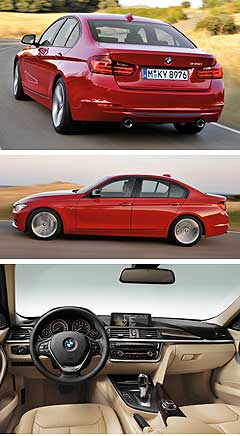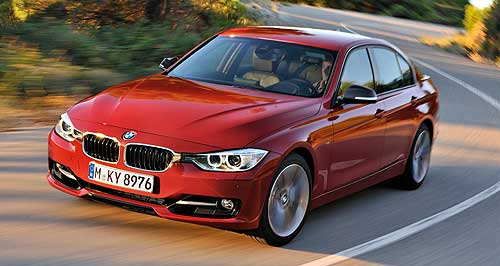Make / Model Search
Future models - BMW - 3 SeriesFirst look: BMW springs its new ‘3’Three's a crowd: The all-new BMW 3 Series will come in six body styles, starting with the new sedan in early 2012. Bigger all-new BMW 3 Series to go all turbo – and hybrid – in sixth generation15 Oct 2011 BMW has revealed its all-new sixth-generation 2012 3 Series sedan in Munich ahead of its formal public debut at the Detroit motor show in January. Longer and taller than the current 3 Series, the German marque’s most important model gets an all-turbo engine line-up, including the new four-cylinder TwinPower petrol engines that will almost certainly kick off the new model when it lobs in Australian showrooms from about March. As expected, the new F30 ‘3’ will get all-wheel-drive XDrive and hybrid powertrain variants in the second half of 2012. The BMW ActiveHybrid 3 will combine a 225kW turbo six-cylinder petrol engine with an integrated 40kW electric motor with the eight-speed transmission to deliver fuel economy of less than 6.4 litres per 100km – a saving of about 12.5 per cent on a conventional 3 Series of similar performance. All models will be offered in three levels – or “Lines” in BMW-speak – Sport, Luxury or Modern. An M Sport package is also in the pipeline for later in 2012. BMW confirmed the new 3 Series ultimately will come in more body styles – six this time – all built on a new-from-ground-up platform, with fresh but evolutionary styling that is unmistakeably BMW. Many of the new features introduced recently into BMW’s range in the new 5 Series and 1 Series have made their way into the 3 Series, including eight-speed automatic transmission availability as an alternative to the six-speed manual with all engines, idle-stop, electric-assisted steering, four selectable driving modes and a free-standing multi-function screen driven by the iDrive console knob.  BMW promises improved ride without losing the trademark sporty character of previous models, along with a more spacious rear seat – with and extra 15mm of legroom courtesy of a longer wheelbase – and greater functionality with a new fold-down rear-seat arrangement. BMW promises improved ride without losing the trademark sporty character of previous models, along with a more spacious rear seat – with and extra 15mm of legroom courtesy of a longer wheelbase – and greater functionality with a new fold-down rear-seat arrangement.The new 3 Series will be charged with retaining BMW’s global lead in the mid-sized prestige segment – a lead that has been challenged since the arrival of the new Mercedes-Benz C class. In Australia, 3 Series sales so far this year have fallen 20.5 per cent, to 3082 vehicles, putting it in second place in the up-to-$60,000 medium luxury segment behind the C-class (4587 units), which itself has take a 9.0 per cent hit in sales volume of the first nine months. The sales slippage of the 3 Series is reflected in BMW’s 5.5 per cent dip in overall sales, but even more so in its passenger car sales volumes, which are down 18.3 per cent. BMW now trails both Mercedes and Audi in passenger sales, with only its large SUV turnover – up 19.8 per cent this year – helping it to edge ahead on overall luxury market leadership this year. The arrival of the new 1 Series and updated 5 Series – both of which have gained new TwinPower four-cylinder engines and cheaper entry price points – is expected to give the brand a lift in the last quarter of 2011, but it will be the arrival of the new 3 Series in 2012 that will really get BMW Australia sales executive pulses racing. The new 3 Series is 93mm longer than before, at 4623mm, with a 50mm gain in the wheelbase. The track has been widened front and rear by 37mm and 47mm respectively, giving the new model a strong on-road presence, and yet the overall width is down by 4mm to 1811mm. The height has been raised 9mm to 1429mm, helping to generate an extra 8mm of headroom for passengers. Although mostly bigger than before, the new 3 Series is said to be 40kg lighter than its predecessor. It is also more aerodynamic, with a claimed drag rating of 0.26Cd. Four models will be offered at launch in Europe – 320d, 320d Efficient Dynamics, 328i and 335i, with a further three following within a few months. The new TwinPower four-cylinder engine with its twin-scroll turbocharger will come in one variant to start – the 2.0-litre 180kW version that is about to debut in the revised 5 Series and Z4 in Australia in November and the 1 Series in the second half of next year. It is a certain starter in the 3 Series for Australia, along with the 135kW version of the same engine that will arrive in the 320i a few months later. The 328i’s engine develops 180kW at 5000rpm and 350Nm of torque from a low 1250rpm, pushing the car from zero to 100km/h in 5.9 seconds. Fuel economy comes in at 6.4L/100km – down 11 per cent on its predecessor and better than any petrol 3 Series currently on offer in Australia. CO2 emissions have been cut to 147 grams per kilometre. BMW has also trimmed the thirst of the 3.0-litre TwinPower inline six-cylinder petrol engine of the 335i with also shaving 0.1 seconds off its 0-100km/h sprint time. Maximum power of 225kW is achieved at 5800 rpm, while peak torque of 400Nm is on stream between 1200 and 5000rpm. The 0-100km/h sprint now takes 5.5 seconds – a fraction faster than before – although the automatic version with the new eight-speeder is said to be 0.3 seconds faster. The 335i fuel consumption is now 7.9L/100km for the manual (CO2 emissions at 186g/km), while the auto achieves 7.2L/100km (CO2: 169). Like the turbo six, the four-cylinder 2.0-litre turbo diesel of the 520d and 520d Efficient Dynamics is a carryover the from the previous generation, but also gains great efficiency. Power and torque of the 320d are unchanged at 135kW at 4000 rpm and 380Nm between 1750 and 2750 rpm, but the manual and auto 320d’s average fuel consumption are both now 4.5L/100km, with CO2 emissions improved by 118g/km – again a four per cent for the manual and 16 per cent for the auto. The 320d Efficient Dynamics Edition develops less power than the 520d, at 120kW, but the same 380Nm of torque. Fuel consumption is the class-leading at 4.1L/100km, with CO2 emissions of 109g/km. Apart from the switch to electric-assisted power steering to help cut weight and improve fuel efficiency, the chassis is similar in design to the previous model, although the front strut set up gets more aluminium for lower unsprung weight. The proven five-link rear suspension has been retained, but like the front suspension, it has been reworked for better ride and improved noise insulation. While the new 1 Series gets three drive modes in its Driving Experience Control, the 3 Series goes one better with four – comfort, sport and sport+ and EcoPro – with the latter helping to shave fuel consumption by backing off throttle responsiveness and other controls. The 3 Series becomes the first in class to get a full-colour head-up display, projecting information on to the windscreen in front of the driver.  Read moreAll future models Alfa Romeo Alfa Romeo Abarth Abarth Alpine Alpine Alpina Alpina Audi Audi Aston Martin Aston Martin BMW BMW Bentley Bentley Chery Chery Brabham Brabham Chrysler Chrysler Chevrolet Chevrolet Cupra Cupra Citroen Citroen DS DS Dodge Dodge Fiat Fiat Ferrari Ferrari Foton Foton Ford Ford Great Wall Great Wall FPV FPV Haval Haval GWM GWM Honda Honda Holden Holden Hummer Hummer HSV HSV Infiniti Infiniti Hyundai Hyundai Jaguar Jaguar Isuzu Isuzu Kia Kia Jeep Jeep Land Rover Land Rover Lamborghini Lamborghini Lexus Lexus LDV LDV Mahindra Mahindra Lotus Lotus Mazda Mazda Maserati Maserati Mercedes-AMG Mercedes-AMG McLaren McLaren MG MG Mercedes-Benz Mercedes-Benz Mitsubishi Mitsubishi Mini Mini Opel Opel Nissan Nissan Peugeot Peugeot Pagani Pagani Proton Proton Porsche Porsche Renault Renault Ram Ram Rover Rover Rolls-Royce Rolls-Royce Skoda Skoda Saab Saab SsangYong SsangYong Smart Smart Suzuki Suzuki Subaru Subaru Toyota Toyota Tesla Tesla Volvo Volvo3 Series pricing
Motor industry news |
Click to shareBMW modelsAll future models Alfa Romeo Alfa Romeo Abarth Abarth Alpine Alpine Alpina Alpina Audi Audi Aston Martin Aston Martin BMW BMW Bentley Bentley Chery Chery Brabham Brabham Chrysler Chrysler Chevrolet Chevrolet Cupra Cupra Citroen Citroen DS DS Dodge Dodge Fiat Fiat Ferrari Ferrari Foton Foton Ford Ford Great Wall Great Wall FPV FPV Haval Haval GWM GWM Honda Honda Holden Holden Hummer Hummer HSV HSV Infiniti Infiniti Hyundai Hyundai Jaguar Jaguar Isuzu Isuzu Kia Kia Jeep Jeep Land Rover Land Rover Lamborghini Lamborghini Lexus Lexus LDV LDV Mahindra Mahindra Lotus Lotus Mazda Mazda Maserati Maserati Mercedes-AMG Mercedes-AMG McLaren McLaren MG MG Mercedes-Benz Mercedes-Benz Mitsubishi Mitsubishi Mini Mini Opel Opel Nissan Nissan Peugeot Peugeot Pagani Pagani Proton Proton Porsche Porsche Renault Renault Ram Ram Rover Rover Rolls-Royce Rolls-Royce Skoda Skoda Saab Saab SsangYong SsangYong Smart Smart Suzuki Suzuki Subaru Subaru Toyota Toyota Tesla Tesla Volvo Volvo3 Series pricing
Motor industry news |











Facebook Twitter Instagram